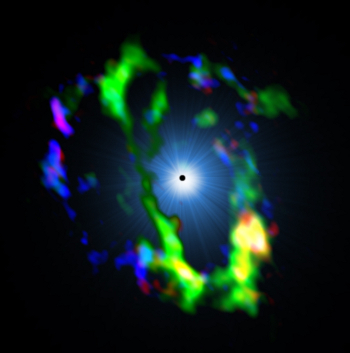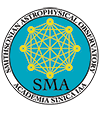 |
|
|
|
SMA 2009 Image Contest Winner: Surviving The Hole | ||||
|
The central few parsecs of the Milky way, located at a distance of 8 kpc, host what is likely the most hostile environment for the interstellar medium found in our Galaxy. This image shows an RGB composite of the emission of three different molecular species in the vicinity of the supermassive black hole, with a mass of several million solar masses, at the position of the compact radio source Sgr A*. The molecular clouds in this region have to overcome extreme physical conditions of density, temperature and disruptive forces such as strong tidal forces, turbulence and cloud collisions. On top of that, these clouds endure the intense pervasive X-ray and UV radiation from both the black hole and the central massive star cluster, as depicted by the blue flare added to the actual SMA data. The few molecules that survive these conditions provide us with a valuable information on the physical processes taking place in this region. The bright emission of cyanogen radical (CN, in green) traces the circumnuclear disk extended ~1.5' (3.5 pc) in diameter around the black hole. On the other hand, Formaldehyde (H2CO, in blue), is mostly dissociated in the inner region and mostly traces the outter dense gas. Finally, the Silicon monoxide (SiO, in red), efficiently formed in the surface of dust grains, reveals the location of material affected by high velocity shocks fronts. This 9 pointing mosaic prove the imaging capabilities of the SMA, with the combination of a large field of view (~1 arcmin.) and a spatial resolution of ~3 arcsec. in this image. The black hole depicted at the center of the image as a black circle, is roughly the resolution of this image.
|

Sergio Martin Ruiz (Harvard-Smithsonian CfA), 2009 Click here for larger view | |||
|
|
